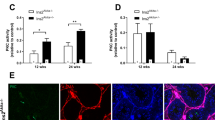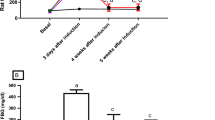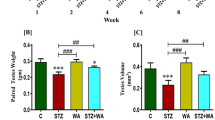Abstract
Earlier, we have shown the occurrence of oxidative impairments and their progression in the testis of diabetic adult rats. This study investigated the vulnerability of immature testis to oxidative stress and mitochondrial dysfunctions in a prepubertal (PP) diabetic rat model. PP male rats (4/6-week-old) rendered diabetic by an acute dose of streptozotocin were monitored for induction of oxidative stress in testis cytosol/mitochondria. Diabetic rats of both age groups showed severe hyperglycemia, testicular atrophy and marked oxidative damage as evidenced by enhanced generation of reactive oxygen species, hydroperoxide and malondialdehyde levels (4 week>6 week). Mitochondrial dysfunctions manifested as reduction in the activities of aldehyde dehydrogenase, tricarboxylic acid cycle enzymes, enhanced activities of oxidative phosphorylation enzymes, perturbations in calcium homeostasis and membrane potential. These evidences suggest that an immature testis is vulnerable to oxidative stress under diabetes, which may play a significant role in the development of testicular degeneration, leading to impaired fertility in adulthood.
This is a preview of subscription content, access via your institution
Access options
Subscribe to this journal
Receive 8 print issues and online access
$259.00 per year
only $32.38 per issue
Buy this article
- Purchase on Springer Link
- Instant access to full article PDF
Prices may be subject to local taxes which are calculated during checkout


Similar content being viewed by others
References
Zimmet P, Alberti KGMM, Shaw J . Global and societal implications of the diabetes epidemic. Nature 2001; 414: 782–787.
Robertson RP, Harmon JS . Diabetes, glucose toxicity, and oxidative stress: a case of double jeopardy for the pancreatic islet β cell. Free Radic Biol Med 2006; 41: 177–184.
Varvarovska J, Racek J, Stozicky F, Soucek J, Trefil L, Pomahacova R . Parameters of oxidative stress in children with type1 diabetes mellitus and their relatives. J Diabetes Complications 2003; 17: 7–10.
Pinhas-Hamiel O, Zeitler P . The global spread of type2 diabetes mellitus in children and adolescents. J Pediatr 2005; 146: 693–700.
Lenzen S . The mechanism of alloxan- and streptozotocin-induced diabetes. Diabetologia 2008; 51: 216–226.
Paz G, Homonnai ZT . Leydig cell function in streptozotocin-induced diabetic rats. Experentia 1979; 35: 1412–1413.
Sexton WJ, Jarrow JP . Effect of diabetes mellitus upon male reproductive function. Urology 1997; 49: 508–513.
Scarano WR, Messias AG, Oliva SU, Klinefelter GR, Kempinas WG . Sexual behaviour, sperm quality after short term streptozotocin induced hyperglycemia in rats. Int J Androl 2006; 29: 482–488.
Agarwal A, Said TM . Oxidative stress, DNA damage and apoptosis in male fertility: a clinical approach. BJU Int 2005; 95: 503–507.
Shrilatha B, Muralidhara . Occurrence of oxidative impairments, response of antioxidant defenses and associated biochemical perturbations in male reproductive milieu in streptozotocin diabetic rats. Int J Androl 2007a; 30: 508–518.
Shrilatha B, Muralidhara . Early oxidative stress and epididymal sperm in streptozotocin induced diabetic mice: its progression and genotoxic consequences. Reprod Toxicol 2007b; 23: 578–587.
Vaithinathan S, Saradha B, D’Cruz SC, Mathur PP . Apoptosis in testis: the hostile role of environmental toxicants. In: Sharma RS, Rajanna A, Rajalakshmi M (eds). Recent Advances and Challenges in Reproductive Health Research. Indian Council of Medical Research: New Delhi, 2008, pp 379–391.
Bauche F, Fouchard MH, Jegou B . Antioxidant system in rat testicular cells. FEBS Lett 1994; 349: 392–396.
Samanta L, Roy A, Chainy GB . Changes in rat testicular defence profile as a function of age and its impairment by hexachlorocyclohexane during critical stages of maturation. Andrologia 1999; 31: 83–90.
Thyagaraju BM, Muralidhara . Vulnerability of prepubertal mice testis to iron induced oxidative dysfunctions in vivo and functional implications. Int J Fertil Steril 2008; 4: 147–156.
Trounce IA, Kim YL, Jun AS, Wallace DC . Assessment of mitochondrial oxidative phosphorylation in patient with muscle biopsies, lymphoblasts and transmitochondrial cell lines. Methods Enzymol 1996; 264: 484–509.
Chandrashekar KN, Muralidhara . Oxidative alterations induced by D-aspartic acid in prepubertal rat testis in vitro; a mechanistic study. Theriogenology 2008; 70: 97–104.
Wolf SP . Ferrous iron oxidation in presence of ferric ion indicator xylenol orange for measurement of hydroperoxides. Methods Enzymol 1994; 233: 182–189.
Ohakawa H, Ohishi U, Yagi K . Assay of lipid peroxides in animal tissues by thiobarbituric reaction. Anal Biochem 1979; 95: 145–149.
Levine RL, Garland D, Oliver C, Amici A, Climent I, Lenz A et al. Determination of carbonyl content in oxidatively modified proteins. Methods Enzymol 1990; 186: 464–478.
Hissin PJ, Hilf R . A fluorimetric method for determination of oxidized and reduced glutathione in tissues. Anal Biochem 1976; 74: 214–216.
Ellman GL . Tissue sulfhydryl groups. Arch Biochem Biophys 1959; 82: 70–77.
Omaye ST, Turnball JD, Sauberlich HE . Selected method for determination of ascorbic acid in animal cells, tissues and fluids. Methods Enzymol 1971; 62: 1–11.
Aebi H . Catalase in vitro. Methods Enzymol 1984; 105: 121–125.
Vladimir A, Kostyuk VA, Potapovich AI . Superoxide driven oxidation of quercetin and a simple sensitive assay for determination of superoxide dismutase. Biochem Int 1989; 19: 1117–1124.
Flohe L, Gunzler WA . Assays of glutathione peroxidase. Methods Enzymol 1984; 105: 114–121.
Guthenberg C, Alin P, Mannervik B . Glutathione transferase from rat testis. Methods Enzymol 1985; 113: 507–510.
Carlberg I, Mannervick FT, Dryle DD . Glutathione reductase. Methods Enzymol 1985; 489–490.
Canuto RA, Garcea R, Pascale M, Pirisi L, Feo F . The subcellular distribution and properties of aldehyde dehydrogenase of heptoma AH-120. Eur J Cancer Clin Oncol 1983; 19: 389–400.
Geralch U . Sorbitol dehydrogenase. In: Bergmeyer HU (ed). Methods of enzymatic analysis. Academic Press: New York, 1963, pp 761–764.
Goldberg E, Hawtrey C . The ontogeny of sperm specific lactate dehydrogenase in mice. J Exp Zool 1967; 164: 309–316.
Luthman M, Holmgern A . Rat liver thioredoxin and thioredoxin reductase: purification and characterization. Biochem J 1982; 21: 6628–6633.
Qujeq D . Development of a quantitative assay method for 3-beta hydroxysteroid dehydrogenase in rat testis. Steroids 2002; 67: 1071–1077.
Srere PA . Citrate Synthase. Methods Enzymol 1969; 13: 3–26.
Penington R . Biochemistry of dystrophic muscle. Mitochondrial succinate tetrazolium reductase and adenosine triphosphatease. Biochem J 1961; 80: 649–654.
Navarro A, Gomez C, Lopez-Cepero JA, Boveris A . Beneficial effects of moderate exercise on mice aging: survival, behavior: oxidative stress and mitochondrial electron transfer. Am J Physiol Regul Integr Comp Physiol 2004; 286: 505–511.
Navarro A, Sanchez Del Pino MJ, Gomez C, Peralta JL, Boveris A . Behavioural dysfunction, brain oxidative stress, and impaired mitochondrial electron transfer in aging mice. Am J Physiol Regul Integr Comp Physiol 2002; 282: 985–992.
Andersson BS, Aw TY, Jones DP . Mitochondrial transmembrane potential and pH gradient during anoxia. Am J Physiol 1987; 252: 349–355.
Rigobello MP, Folda A, Scutari G, Bindoli A . The modulation of thiol redox state affects the production and metabolism of hydrogen peroxide by heart mitochondria. Arch Biochem Biophys 2005; 441: 112–122.
Hitoshi A, Satoh T, Sakai N, Yamada M, Enokido Y, Ikeuchi T et al. Generation of free radicals during lipid peroxide triggered apoptosis in PC12h cells. Biochim Biophys Acta 1997; 1345: 35–42.
Lowry OH, Rosebrough NJ, Farr AL, Randall RJ . Protein measurement using folin-phenol reagent. J Biol Chem 1951; 193: 265–275.
Spear LP . Assessment of adolescent neurotoxicity: rationale and methodological considerations. Neurotoxicol Teratol 2007; 20: 1–9.
Kume E, Fuijimura H, Matsuki N, Ito M, Aruga C, Toriumi W et al. Hepatic changes in the acute phase of streptozotocin (STZ)-induced diabetes in mice. Exp Toxicol Pathol 2004; 55: 467–480.
Sun J, Devish K, Langer WJ, Carmines PK, Lane PH . Testosterone treatment promotes tubular damage in experimental diabetes in prepubertal rats. Am J Physiol Renal Physiol 2007; 292: 1681–1690.
Roselli M, Keller PJ, Dubey RK . Role of nitric oxide in the biology, physiology and pathophysiology of reproduction. Hum Reprod Update 1998; 4: 3–24.
Imaeda A, Kaneko T, Aoki T, Kondo Y, Nagase H . DNA damage and the effect of antioxidants in streptozotocin treated mice. Food Chem Toxicol 2002; 40: 979–987.
Kobayashi T, Kaneko T, Luchi Y, Matsuki S, Takahashi M, Sasagawa I et al. Localization and physiological implication of aldose reductase and sorbitol dehydrogenase in reproductive tracts and spermatozoa of male rats. J Androl 2002; 23: 674–683.
Kostic TS, Andric SA, Maric D, Kovacevic RZ . Inhibitory effects of stress activated nitric oxide on antioxidant enzymes and testicular steroidogenesis. J Steroid Biochem Mol Biol 2000; 75: 299–306.
Narayana K . A purine nucleoside analogue-acyclovir {9-(2-hydroxyethoxymethyl)-9h-guanine} reversibly impairs testicular functions in mouse. J Toxicol Sci 2008; 33: 61–70.
Maechler P, Wolheim CM . Mitochondrial function in normal and diabetic β-cells. Nature 2001; 414: 807–812.
Yarian CS, Toroser D, Sohal RS . Aconitase is the main functional target of aging in the citric acid cycle of kidney mitochondria from mice. Mech Ageing Dev 2006; 127: 79–84.
Moon KH, Kim BJ, Song BJ . Inhibition of mitochondrial aldehyde dehydrogenase by NO-mediated-S-nitrosylation. FEBS lett 2005; 579: 6115–6120.
Vyssokikh MY, Brdiczka D . The function of complexes between the outer mitochondrial membrane pore (VDAC) and the adenine nucleotide translocase in regulation of energy metabolism and apoptosis. Acta Biochim Pol 2003; 50: 389–404.
Acknowledgements
This study was supported by a grant from the Department of Science and Technology (DST) New Delhi, Government of India (DST-SR/SO/AS-48), to the senior author. The first author (KNC) gratefully acknowledges the granting agency for the financial assistance in the form of a Junior Research Fellowship.
Author information
Authors and Affiliations
Corresponding author
Rights and permissions
About this article
Cite this article
Chandrashekar, K., Muralidhara Evidence of oxidative stress and mitochondrial dysfunctions in the testis of prepubertal diabetic rats. Int J Impot Res 21, 198–206 (2009). https://doi.org/10.1038/ijir.2009.9
Received:
Revised:
Accepted:
Published:
Issue Date:
DOI: https://doi.org/10.1038/ijir.2009.9
Keywords
This article is cited by
-
Withaferin-A attenuates diabetes mellitus induced male reproductive dysfunction mediated by ERα in brain and testes of Swiss albino mice
Scientific Reports (2023)
-
Chemoprotective effects of inositol hexaphosphate against cyclophosphamide-induced testicular damage in rats
Scientific Reports (2020)
-
Oral supplementation of standardized extract of Withania somnifera protects against diabetes-induced testicular oxidative impairments in prepubertal rats
Protoplasma (2014)
-
Dracaena arborea alleviates ultra-structural spermatogenic alterations in streptozotocin-induced diabetic rats
BMC Complementary and Alternative Medicine (2013)



